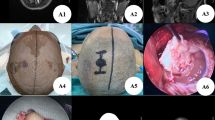Abstract
Purpose
Visualizing a brain in its native space plays an essential role during neurosurgical planning because it allows the superficial cerebral veins and surrounding regions to be preserved. This paper describes the use of a visualization tool in which single gadolinium contrast-enhanced T1-weighted magnetic resonance imaging was applied in nondefective and nonresective skulls to promote visualization of important structures.
Methods
A curvilinear reformatting tool was applied on the supratentorial compartment to peel the tissues to the depth of the dura mater and thereby revealing cortical and vascular spatial relationships. The major advantage of our proposed tool is that it does not require coregistration of anatomical and vascular volumes.
Results
The reliability of this technique was supported by comparisons between preoperative images and digital photographs of the brain cortical surface obtained after the dura mater was removed in 20 patients who underwent surgery in the Clinics Hospital of the University of Campinas from January 2017 to April 2018.
Conclusion
Single fat-suppressed GAD contrast-enhanced T1-weighted magnetic resonance scans provide accurate preoperative 3D views of cortical and vascular relationships similar to neurosurgeons’ intraoperative views. In developing countries with limited access to state-of-the-art health technologies, this imaging approach may improve the safety of complex neurosurgeries.










Similar content being viewed by others
Notes
A triangle with brighter signals is the one that contains samples with a signal intensity at the 70th percentile of the intensities of all projected triangle samples in the ray length of 50 mm. In our tests, 12 uniformly spaced points in barycentric coordinates in each triangle are sufficient for this evaluation.
Electronic supplementary material accompanying this manuscript.
References
Bastos AC, Comeau RM, Andermann F, Melanson D, Cendes F, Dubeau F, Fontaine S, Tampieri D, Olivier A (1999) Diagnosis of subtle focal dysplastic lesions: curvilinear reformatting from three-dimensional magnetic resonance imaging. Ann Neurol 46(1):88–94
Bi WL, Brown PA, Abolfotoh M, Al-Mefty O, Mukundan S, Dunn IF (2015) Utility of dynamic computed tomography angiography in the preoperative evaluation of skull base tumors. J Neurol 123(1):1–8
Gering DT, Nabavi A, Kikinis R, Hata N, O’Donnell LJ, Grimson WE, Jolesz FA, Black PM, Wells WM (2001) An integrated visualization system for surgical planning and guidance using image fusion and an open MR. J Magn Reson Imaging 13(6):967–975. https://doi.org/10.1002/jmri.1139
Hamid OA, Hasaballah MS, Hamdy TAH (2014) The lower border of the zygomatic arch could be a better landmark for the middle fossa dura: Cadaveric dissection study. Egypt J Ear Nose Throat Allied Sci 15(3):177–181. https://doi.org/10.1016/j.ejenta.2014.06.004
Huempfner-Hierl H, Bohne A, Schaller A, Wollny G, Hierl T (2015) Does facial soft tissue protect against zygomatic fractures? Results of a finite element analysis. Head Face Med. https://doi.org/10.1186/s13005-015-0078-5
Huppertz HJ, Kassubek J, Altenmüller DM, Breyer T, Fauser S (2008) Automatic curvilinear reformatting of three-dimensional MRI data of the cerebral cortex. NeuroImage 39(1):80–86
Iglesias JE, Liu CY, Thompson PM, Tu Z (2011) Robust brain extraction across datasets and comparison with publicly available methods. IEEE Trans Med Imaging 30(9):1617–1634
Loos WS, Yasuda CL, Cendes F, Wu ST (2017) Cortical envelope modeling for interactive patient-customized curvilinear reformatting in the native space. In: Cardoso M et al (eds) Imaging for patient-customized simulations and systems for point-of-care ultrasound (BIVPCS 2017, POCUS 2017), lecture notes in computer science, vol 10549. Springer, Cham
Mäntylä M (1987) An introduction to solid modeling. Computer Science Press Inc., New York
Moringlane JR, Bartylla K, Hagen T, Waziri A (1997) Stereotactic neurosurgery planning with 3-D spiral CT-angiography. Minim Invasive Neurosurg 40:83–86. https://doi.org/10.1055/s-2008-1053422
Nowell M, Sparks R, Zombori G, Miserocchi A, Rodionov R, Diehl B, Wehner T, White M, Ourselin S, McEvoy A, Duncan J (2016) Resection planning in extratemporal epilepsy surgery using 3D multimodality imaging and intraoperative MRI. Br J Neurosurg 31(4):468–470. https://doi.org/10.1080/02688697.2016.1265086
Sellers G, Wright RS, Haemel N (2015) OpenGL superbible: comprehensive tutorial and reference, 7th edn. Addison-Wesley, Toronto
Smith SM (2002) Fast robust automated brain extraction. Hum Brain Mapp 17(3):143–155. https://doi.org/10.1002/hbm.10062
Tubbs RS, O’Neil JT, Key CD, Zarzour JG, Fulghum SB, Kim EJ, Lyerly M, Shoja MM, Salter EG, Oakes WJ (2007) Superficial temporal artery as an external landmark for deeper-lying brain structures. Clin Anat 20:498–501. https://doi.org/10.1002/ca.20363
VMTK-Neuro (2017) http://www.dca.fee.unicamp.br/projects/mtk/vmtk-neuro/index.html. Accessed 26 Feb 2018
Weiskopf D, Engel K, Ertl T (2003) Interactive clipping techniques for texture-based volume visualization and volume shading. IEEE Trans Vis Comput Graph 9(3):298–312. https://doi.org/10.1109/TVCG.2003.1207438.3,8
Wu ST, Valente AC, de Souza Watanabe L, Yasuda CL, Coan AC, Cendes F (2014) Pre-alignment for co-registration in native space. In: 2014 27th SIBGRAPI conference on graphics, patterns and images, pp 41–48
Wu ST, Yasuda CL, Cendes F (2012) Interactive curvilinear reformatting in native space. IEEE Trans Visual Comput Graph 18(2):299–308
Acknowledgements
We would like to acknowledge Alisson V. S. Lima for helping with the exhaustive validation tests. This study was supported by a CNPq-Brazil fellowship (305785/2012-5, 308764/2015-3), a CNPq-Brazil scholarship (165777/2014-1), a Fapesp Individual Project Grant (#2011/02351-0), a Fapesp-Brazil Grant (#2013/07559-3) to the BRAINN Research, Innovation and Dissemination Center of the University of Campinas, and a SAE-Unicamp scholarship.
Author information
Authors and Affiliations
Corresponding author
Ethics declarations
Conflict of interest
The authors declare they have no conflicts of interest.
Informed consent
The volunteers enrolled in the present study signed an informed consent form approved by the Ethics Committee of the University of Campinas.
Electronic supplementary material
Below is the link to the electronic supplementary material.
Rights and permissions
About this article
Cite this article
Wu, ST., Loos, W.S., de Castro Oliveira, D.L. et al. Interactive patient-customized curvilinear reformatting for improving neurosurgical planning. Int J CARS 14, 851–859 (2019). https://doi.org/10.1007/s11548-018-1878-4
Received:
Accepted:
Published:
Issue Date:
DOI: https://doi.org/10.1007/s11548-018-1878-4




